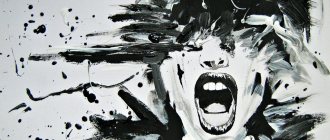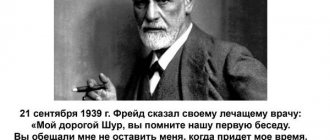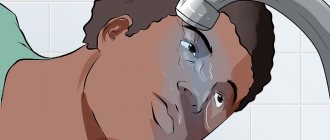Types of reflection
A. Karpov, as well as other researchers, identified the following types of reflection: situational, retrospective, prospective.
Situational reflection is motivation and self-assessment that ensures the subject’s involvement in the situation, as well as analysis of what is happening and comprehension of the elements of analysis. This type is characterized by the ability to relate one’s own actions to the objective situation, the ability to control and coordinate elements of activity depending on changing conditions.
Retrospective reflection of a person is an analysis of events, activities performed, and events that took place in the past.
Prospective reflection is thinking about upcoming activities, planning, presenting the progress of activities, choosing the most effective ways to implement them, predicting possible results.
Other researchers distinguish elementary, scientific, philosophical, psychological, and social reflection. The elementary goal is consideration and analysis by the individual of his own actions and knowledge. This type is characteristic of every individual, since everyone thought about the causes of mistakes and failures in order to change ideas about the environment and the world, correct mistakes, and prevent them in the future. This state allows you to learn from personal mistakes.
Scientific reflection is aimed at a critical study of scientific methods, the study of scientific knowledge, methods for obtaining scientific results, and procedures for substantiating scientific laws and theories. This state finds expression in the methodology of scientific knowledge, logic, and the psychology of scientific creativity.
Social reflection is understanding another individual through thinking for him. It is classified as internal betrayal. Representing what others think of an individual is important in social cognition. This is knowing the other (but I think) as they think about me and knowing myself presumably through the eyes of another. A wide circle of friends allows a person to know a lot about himself.
BodyPsychologyBody psychology
2. Retrospective reflection. Serves to analyze activities already completed and events that took place in the past. Reflection in this case affects the prerequisites, motives, conditions, stages and results of an activity or its individual stages that are already in the past.
3. Perspective reflection. Includes thinking about upcoming activities, imagining the progress of activities, planning, choosing the most effective methods of implementation, predicting possible results. Houses in Foros apartments in Crimea https://www.yaltabest.ru. Real estate in Yalta for sale.
In addition, a differentiation is usually made into intellectual and personal reflection [98]. Intellectual reflection is aimed at analyzing the substantive content of a problem situation and one’s place in it, which, in turn, is determined by the content of a life task, as well as the possibility of its transformation. Personal reflection is directed at the person himself who finds himself in the search process, and accordingly leads to a rethinking of his entire activity as a whole.
In our opinion, the theoretical significance of the classification of the main types and levels of reflection lies not only in overcoming the narrowing of the concept, but also in determining the dual (both personal and interpersonal) nature of reflexive phenomena, as well as the multi-level organization of reflexive processes both in the structure of an individual and in a communicative and cooperative space.
In addition, many authors note that reflection is a theoretical activity aimed at understanding one’s own actions and their laws. Reflection is ultimately an awareness of practice. V. I. Slobodchikov identifies three contexts in which the problem of reflection is developed: a) in the study of theoretical thinking (in science, philosophy, methodology); b) when studying the processes of communication and cooperation of actions of participants in these processes; c) in studies of individual self-awareness related to problems of personality formation, education and self-education [90].
At present, in the structure of psychological knowledge itself, the framework of which we will limit ourselves to in the further analysis of reflexive processes, three leading directions have emerged in the development of problems of reflection: studies of a person’s reflexive self-awareness, work on creative thinking, and the study of reflection as a person’s cognition of the phenomena of someone else’s consciousness [28].
In accordance with this classification, we tried to summarize the material concerning the theoretical understanding of reflection. Representatives of the first approach explore a person’s self-awareness, his assessment of his actions, control over his behavior, etc. The authors of this kind of concepts are guided by the idea of reflection as “the focus of a person’s cognition on himself, on his inner world, mental qualities and states.” .
The most profound understanding of reflection in this aspect is contained in S.L. Rubinstein, who pointed out that “there are two main ways of human existence and, accordingly, two attitudes towards life. The first is life that does not go beyond the immediate connections in which a person lives. The second is associated with the appearance of reflection, which “suspends”, interrupts the process of life and takes a person mentally beyond its limits. The person seems to take a position outside of it. This is where the path to spiritual emptiness begins. or another path - to building a moral human life on a new conscious basis" [95]. S.L. Rubinstein associates with the emergence of reflection a special way of carrying out human life in society and his relationship to the world: “...it (reflection) seems to suspend, interrupt this continuous process of life and takes a person mentally beyond its limits. From this moment, every human act takes on the character of a philosophical judgment about life” [96, p. 264].
L.S. Vygotsky writes that the basis of awareness is the generalization of one’s own mental processes, leading to mastery of them [56]. Awareness of cognitive processes means, first of all, the possibility of mastering and consciously managing them. In addition, awareness of thoughts makes it possible to solve a number of problems that cannot be solved at the level of complex thinking - tasks that require the establishment of connections between concepts, that is, “supra-empirical” connections that do not exist between phenomena in the real world.
V. Ya. Butorin [56, p. 157], considering the levels of information processing processes, determines the role of reflection and its functioning in these processes. He believes that the distinction between the objective and real levels of consciousness, which is used in the study of scientific knowledge, is also applicable in the study of awareness, that is, reflection. Thus, incoming information is compared with the subject’s existing model of the future (this, according to this approach, is the goal of reflection). Based on such a predictive comparison, an action plan is developed and active management of one’s own (and other people’s) behavior is carried out, aimed at solving a specific problem.
Pages: 5
Primary school age as a period of formation of adequate self-esteem. Psychological and pedagogical characteristics of a personality of primary school age R. S. Nemov considered a person to be a person, a representative of a certain society, a conscious figure occupying a certain position in it, performing social roles, endowed with natural characteristics. According to L.F. Obukhova, a child becomes a personality from birth. However, child development is complex...
Student's method (t-test) [34] This method is used to test the hypothesis about the reliability of the difference in means when analyzing quantitative data in elections with a normal distribution. where x1 and x2 are the arithmetic means of the variables in groups 1 and 2, SΔ is the standard error of the difference. If n1= n2, then where n1 and n2 are the number of elements in the first and second...
Features of social adaptation of children of primary preschool age with intellectual disabilities Considering the features of social adaptation of children with intellectual disabilities. We choose the following criteria: play, communication with adults and peers, self-care for children with intellectual disabilities. Let us take as a basis the works of such authors as I.M. Btazhnokova [6], V.F. Machikhina. [65]. Zabramnoy S.D. [33] It is necessary to consider...
Philosophical reflection
The highest type is philosophical reflection, which includes reflections and reasoning about the foundations of human culture, as well as the meaning of human existence.
Socrates considered the state of reflection to be the most important means of personal self-knowledge, as well as the basis of spiritual improvement. It is the ability of critical self-esteem that is the most important distinguishing feature of an individual as a reasonable person. Thanks to this state, human misconceptions and prejudices are eliminated, and the spiritual progress of humanity becomes real.
Pierre Teilhard de Chardin noted that the reflexive state distinguishes man from animals and allows the individual not only to know something, but also gives the opportunity to know about his knowledge.
Ernst Cassirer believed that reflection is expressed in the ability to isolate certain stable elements from all sensory phenomena for isolation and focusing attention on them.
Psychological reflection
One of the first in psychology to consider the reflexive state was A. Busemann, who interpreted it as the transfer of experiences from the outside world to oneself.
Psychological studies of reflection are presented in two ways:
— the way the researcher understands the grounds, as well as the results of the study;
- a basic property of a subject in which awareness occurs, as well as regulation of one’s life activity.
Reflection in psychology is a person’s reflection, the purpose of which is to consider and analyze one’s own activity, oneself, one’s own states, past events, and actions.
The depth of the state is associated with the individual’s interest in this process, as well as the ability to pay attention to a lesser or greater extent, which is influenced by education, ideas about morality, the development of moral feelings, and the level of self-control. It is believed that individuals of different professional and social groups differ in the use of a reflexive position. This property is considered as a conversation or a kind of dialogue with oneself, as well as the individual’s ability to self-development.
Reflection is a thought that is directed at a thought or at oneself. It can be considered as a secondary genetic phenomenon arising from practice. This is the practice going beyond the boundaries of itself, as well as the practice turning towards itself. The psychology of creative thinking and creativity interprets this process as a rethinking and comprehension by the subject of stereotypes of experience.
The study of the relationship between the individual’s individuality, reflective state, and creativity allows us to talk about the problems of the creative uniqueness of the individual, as well as its development. E. Husserl, a classic of philosophical thought, noted that the reflexive position is a way of seeing that is transformed from the direction of the object.
The psychological characteristics of this condition include the ability to change the content of consciousness, as well as change the structures of consciousness.
The concept of “social reflection”
Social reflection is one of the aspects studied in modern sociological science.
Scientists present it as an internal representation of another in the inner world and ideological attitudes of a person who is able to perceive the surrounding reality and adapt to the requirements of modernity and, accordingly, the requirements of other people. People are very susceptible to how others react to them, so they want they were seen from good sides so that a positive opinion was formed about them.
Note 1
It is also extremely important to emphasize that the wider an individual’s social circle, the more ideas he has about how others perceive him, the more he learns about himself, about what he can be, how others perceive and see his appearance, behavior.
Help with student work on the topic Social Reflection
Coursework 450 ₽ Essay 280 ₽ Test paper 200 ₽
Get completed work or consultation with a specialist on your educational project Find out the cost
The inclusion of a partner in the inner world of another person is one of the most effective sources of one’s own self-knowledge, since only by looking at oneself through the eyes of another person, an individual can see all his strengths and weaknesses, motivate him to change or internal aspirations, which is very important for the development of the human personality .
Social reflection is considered from the point of view of several spaces that allow the individual to see what he already knows and what he can still learn about himself:
- “What is known to me” is what is open in the human personality both to itself and to other people, and what is quite obvious. It can also be qualities of a person that are open to him, but at the same time completely unfamiliar and unknown to other surrounding individuals;
- “Unknown to me” are qualities and characteristics that an individual may not notice about himself, but which are absolutely open to everyone else around him. Also unknown characteristics include those that are closed to both the person and his environment. Subsequently, they may open, or they may be hidden until the end of life. This does not mean that they do not appear in some human actions: rather, they go unnoticed.
Do you need proofreading or review of academic work? Ask a question to the teacher and get an answer in 15 minutes! Ask a Question
Note 2
Thus, communicating with other people, exchanging experience and knowledge with them, a person opens up to himself from new sides, which is extremely important for the development of personality, the acquisition of new qualities that will be useful and extremely necessary in various life situations.
Such versatility allows one to adapt to various social and cultural situations and constantly changing conditions. Adaptability is the most important quality of a modern personality, and it can be achieved, among other things, through conscious reflection, its social elements and aspect component.
Understanding reflection
Russian psychology identifies four approaches to studying the understanding of reflection: cooperative, communicative, intellectual (cognitive), personal (general psychological).
Cooperative is the analysis of subject-subject activities, the design of collective activities aimed at coordinating professional positions, as well as group roles of subjects or cooperation of joint actions.
Communicative is a component of developed communication, as well as interpersonal perception, as a specific quality of cognition of an individual by an individual.
Intellectual or cognitive is the ability of a subject to analyze, highlight, correlate his own actions with an objective situation, and also consider it depending on the study of the mechanisms of thinking.
Personal (general psychological) is the construction of a new image of one’s “I”, in the process of communication with other individuals, as well as active activity and the development of new knowledge about the world around us.
Personal reflection consists of a psychological mechanism for changing individual consciousness. A.V. Rossokhin believes that this aspect is a subjective active process of generating meaning, which is based on the unique ability of the individual to be aware of the unconscious. This is internal work, leading to the formation of new strategies, methods of internal dialogue, changes in value and semantic formations, integration of the individual into a new and holistic state.
Reflection of activity
Reflection is considered a special skill, which consists in the ability to realize the direction of attention, as well as track the psychological state, thoughts, and sensations. It provides an opportunity to observe oneself as if from the outside through the eyes of an outsider, allowing one to see where exactly one’s attention is concentrated and its direction. Modern psychology understands by this concept any reflection of an individual that is aimed at introspection. This is an assessment of your condition, actions, reflection on any events. The depth of self-analysis depends on the level of morality, education of a person, and his ability to control himself.
Reflection of activity is the main source of new ideas. The reflective state, providing certain material, can subsequently serve for observation as well as criticism. The individual changes as a result of self-analysis and the reflexive position represents a mechanism that makes implicit thoughts explicit. Under certain conditions, the reflective state becomes a source of obtaining even deeper knowledge than what we possess. The professional development of an individual is directly related to this condition. Development itself occurs not only technically, but also intellectually and personally. A person for whom reflection is alien does not control his life and the river of life carries him in the direction of the flow.
Reflection of activity allows the individual to realize what the person is doing now, where he is and where he needs to move in order to develop. A reflective state aimed at understanding the reasons, as well as the basis of personal judgments, is often referred to as philosophy.
Reflection of activity is important for a person engaged in intellectual work. It is needed when interpersonal group interaction is necessary. For example, management relates to this case. Reflection must be differentiated from the individual’s self-awareness.
How to write a term paper on speech therapy
07.09.2010 221438
These guidelines are compiled to help students gain an understanding of the content and structure of coursework in speech therapy.
Logopedia of pedagogical science that studies anomalies of speech development with normal hearing, explores the manifestations, nature and mechanisms of speech disorders, develops the scientific basis for overcoming and preventing them means of special training and education.
The subject of speech therapy as a science is speech disorders and the process of training and education of persons with speech disorders.
The object of study is a person suffering from a speech disorder.
The main task of speech therapy as a science is the study, prevention and elimination of various types of speech disorders.
Coursework in speech therapy is a student's scientific and experimental research. This type of educational activity, provided for by the educational and professional program and curriculum, contributes to the acquisition of skills in working with literature, analyzing and summarizing literary sources in order to determine the range of insufficiently studied problems, determining the content and methods of experimental research, processing skills and qualitative analysis of the results obtained. The need to complete coursework in speech therapy is due to the updating of knowledge concerning the content, organization, principles, methods and techniques of speech therapy work.
As a rule, during their studies, students must write two term papers - theoretical and practical.
The first course work should be devoted to the analysis and synthesis of general and specialized literature on the chosen topic. Based on this analysis, it is necessary to justify and develop a method of ascertaining (diagnostic) experiment.
In the second course work, it is necessary to provide an analysis of the results obtained during the ascertaining experiment, as well as determine the directions and content of speech therapy work, and select adequate methods and techniques of correction.
So, let’s present the general requirements for the content and design of coursework in speech therapy.
The initial and most important stage of working on a course project is the choice of a topic, which is either proposed by the supervisor or chosen by the student independently from a list of topics that are consistent with the areas of scientific research of the department.
Each topic can be modified, considered in different aspects, but taking into account a theoretical and practical approach. Having chosen a topic, the student needs to think through in detail its specific content, areas of work, practical material, etc., which should be reflected both in the formulation of the topic and in the further construction of the study. It should be recalled that the chosen topic may not only have a purely theoretical orientation, for example: “Dysarthria. Characteristics of the defect”, “Classification of dysgraphia”, but also take into account the practical significance of the problem under consideration, for example: “Speech therapy work on speech correction for dysarthria”. It should also be taken into account that when formulating a topic, excessive detail should be avoided, for example: “Formation of prosodic components of speech in preschoolers of the sixth year of life attending a preschool institution for children with severe speech impairments.”
The course work includes such mandatory parts as: introduction, three chapters, conclusion, bibliography and appendix.
The text of the term paper begins with the title page . An example of its design can be seen here.
Then the content of the work is given, in which the names of chapters, paragraphs, and sections are formulated in strict accordance with the content of the thesis. An example of its design can be seen here.
In the text, each subsequent chapter and paragraph begins on a new page. At the end of each chapter, the materials are summarized and conclusions are formulated.
The introduction reveals the relevance of the problem under consideration in general and the topic being studied in particular; the problem, subject, object, and purpose of the study are defined. In accordance with the goal and hypothesis, objectives and a set of research methods aimed at achieving the objectives must be defined.
The relevance of the topic lies in reflecting the current level of pedagogical science and practice, meeting the requirements of novelty and usefulness.
When defining the research problem, it is important to indicate what practical tasks it will help to implement in training and educating people with speech pathology.
The object of research is understood as certain aspects of pedagogical reality, perceived through a system of theoretical and practical knowledge. The ultimate goal of any research is to improve this object.
The subject of research is some part, property, element of an object, i.e. the subject of research always indicates a specific aspect of the object that is to be studied and about which the researcher wants to gain new knowledge. An object is a part of an object.
You can give an example of the formulation of the object, subject and problem of research:
– The object of the study is the speech activity of preschool children with phonetic-phonemic speech disorders.
– The subject of the study is the features of intonation speech of children with phonetic-phonemic speech disorders.
– The research problem is to determine effective directions for speech therapy work on the formation of intonation expressiveness of speech in the system of correctional intervention.
The purpose of the study contributes to the specification of the object being studied. The goal of any research is to solve a specific problem. The goal is specified in tasks taking into account the subject of research.
The research objectives are formulated in a certain sequence, which determines the logic of the research. The research objectives are set on the basis of a theoretical analysis of the problem and an assessment of the state of its solution in practice.
The first chapter is an analysis of literary sources, which examines the state of this problem in historical and modern aspects, and presents the most important theoretical principles that formed the basis of the study.
When writing the first chapter, you should pay attention to the fact that the text of the course work must be written in a scientific style. When presenting scientific material, it is necessary to comply with the following requirements:
– Specificity – a review of only those sources that are necessary to disclose only a given topic or solve only a given problem;
– Clarity – which is characterized by semantic coherence and integrity of individual parts of the text;
– Logicality – which provides for a certain structure of presentation of the material;
– Reasoning – evidence of thoughts (why this and not otherwise);
– Precision of wording, excluding ambiguous interpretation of the authors’ statements.
A literary review of the state of the problem being studied should not be reduced to a consistent presentation of literary sources. It should present a generalized description of the literature: highlight the main directions (currents, concepts, points of view), analyze in detail and evaluate the most fundamental works of representatives of these directions.
When writing a work, the student must correctly use literary materials, make references to the authors and sources from which the results of scientific research are borrowed. Failure to provide required references will reduce your coursework grade.
As a rule, in coursework on speech therapy, references to literary sources are formatted as follows: the number of the cited source in the general list of references is placed in square brackets. For example: General speech underdevelopment is a speech pathology in which there is a persistent lag in the formation of all components of the language system: phonetics, vocabulary and grammar [17].
When using quotations, in square brackets, in addition to indicating the source number, the page number from which this excerpt is taken is indicated, for example: Speech rhythm is based on a physiological and intellectual basis, since, firstly, it is directly related to the rhythm of breathing. Secondly, being an element that performs a communicative function, “correlates with meaning, i.e. controlled intellectually” [23, P.40].
However, course work should not be of a purely abstract nature, so you should not abuse the unreasonable abundance of citations. Quoting should be logically justified, convincing and used only when really necessary.
In the second chapter , devoted to experimental research, the organization should be described and the program of the ascertaining experiment should be presented. The survey methodology, as a rule, consists of a description of several series of tasks, with detailed instructions, visual and lexical material, the procedure for completing tasks by experiment participants, and scoring criteria. This chapter also provides a qualitative and quantitative analysis of the results obtained.
When analyzing the results of an experiment, it is necessary to use a scoring system. Examples of various criteria for quantitative and qualitative assessment are presented in the following works:
– Glukhov V.P. Formation of coherent speech in preschool children with general speech underdevelopment. - M.: Arkti, 2002. - 144 p.
– Fotekova T.A. Test methodology for diagnosing oral speech of primary schoolchildren. - M.: Arkti, 2000. - 56 p.
– Levchenko I.Yu. Pathopsychology: Theory and practice. - M.: Academy, 2000. - 232 p.
In order to visually present the results obtained during the experimental study, it is recommended to use tables, graphs, diagrams, etc. Histograms can be used in a variety of ways - columnar, cylindrical, planar, volumetric, etc. An example of the design of tables, figures, and histograms can be found here.
The third chapter provides a rationale for the proposed methods and techniques and reveals the content of the main stages of correctional work.
The conclusion contains a summary of the material presented and the main conclusions formulated by the author.
The bibliography must contain at least 25 sources. The list includes bibliographic information about the sources used in preparing the work. An example of its design can be seen here.
In the application you can present bulky tables or illustrations, examination protocols, observation records, products of activity (drawings, written works of children), notes from speech therapy classes, etc.
The volume of one course work must be at least 30 pages of typewritten text.
In general, coursework in speech therapy is the basis for a future thesis, in which the study of the begun problem can be continued, but from the standpoint of a different approach or a comparative analysis of the disorders being studied in different age categories of people with different types of speech disorders.
The content and format of theses in speech therapy can be found here.
Literature:
1. How to write a term paper on speech therapy: Methodological recommendations. Educational and methodological manual / Comp. Artemova E.E., Tishina L.A. / Ed. Orlova O.S. – M.: MGOPU, 2008. – 35 p.
2. Research work of students in the system of higher professional pedagogical education (specialty 031800 - Speech therapy). Methodological recommendations for completing the thesis / Compiled by. L.V. Lopatina, V.I. Lipakova, G.G. Golubeva. - St. Petersburg: Publishing house of the Russian State Pedagogical University named after. A. I. Herzen, 2002. - 140 p.
Purpose of reflection
Without reflection there is no learning. An individual who repeats an activity suggested in a model a hundred times may never learn anything.
The purpose of reflection is to identify, remember and understand the components of an activity. These are types, meaning, methods, ways to solve them, problems, results obtained. Without awareness of the methods of learning, the mechanisms of cognition, students are unable to appropriate the knowledge that they have acquired. Learning occurs when guided reflection is involved, thanks to which patterns of activity are identified, namely ways of solving practical problems.
Reflective feeling is an internal experience, a way of self-knowledge, and also a necessary tool for thinking. Reflection is most relevant in distance learning.










